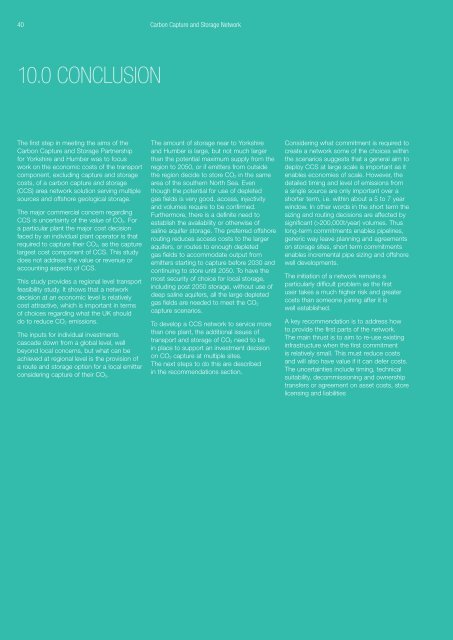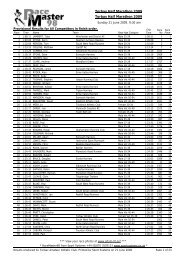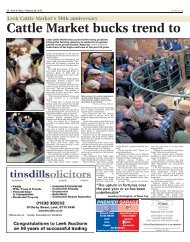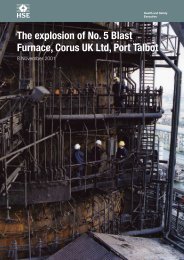A cArbon cApture And storAge network for yorkshire And humber
A cArbon cApture And storAge network for yorkshire And humber
A cArbon cApture And storAge network for yorkshire And humber
Create successful ePaper yourself
Turn your PDF publications into a flip-book with our unique Google optimized e-Paper software.
40<br />
10.0 CONCLUSION<br />
The first step in meeting the aims of the<br />
Carbon Capture and Storage Partnership<br />
<strong>for</strong> Yorkshire and Humber was to focus<br />
work on the economic costs of the transport<br />
component, excluding capture and storage<br />
costs, of a carbon capture and storage<br />
(CCS) area <strong>network</strong> solution serving multiple<br />
sources and offshore geological storage.<br />
The major commercial concern regarding<br />
CCS is uncertainty of the value of CO2. For<br />
a particular plant the major cost decision<br />
faced by an individual plant operator is that<br />
required to capture their CO2, as the capture<br />
largest cost component of CCS. This study<br />
does not address the value or revenue or<br />
accounting aspects of CCS.<br />
This study provides a regional level transport<br />
feasibility study. It shows that a <strong>network</strong><br />
decision at an economic level is relatively<br />
cost attractive, which is important in terms<br />
of choices regarding what the UK should<br />
do to reduce CO2 emissions.<br />
The inputs <strong>for</strong> individual investments<br />
cascade down from a global level, well<br />
beyond local concerns, but what can be<br />
achieved at regional level is the provision of<br />
a route and storage option <strong>for</strong> a local emitter<br />
considering capture of their CO2.<br />
Carbon Capture and Storage Network<br />
The amount of storage near to Yorkshire<br />
and Humber is large, but not much larger<br />
than the potential maximum supply from the<br />
region to 2050, or if emitters from outside<br />
the region decide to store CO2 in the same<br />
area of the southern North Sea. Even<br />
though the potential <strong>for</strong> use of depleted<br />
gas fields is very good, access, injectivity<br />
and volumes require to be confirmed.<br />
Furthermore, there is a definite need to<br />
establish the availability or otherwise of<br />
saline aquifer storage. The preferred offshore<br />
routing reduces access costs to the larger<br />
aquifers, 2 or routes to enough depleted<br />
gas fields to accommodate output from<br />
emitters starting to capture be<strong>for</strong>e 2030 and<br />
continuing to store until 2050. To have the<br />
most security of choice <strong>for</strong> local storage,<br />
including post 2050 storage, without use of<br />
deep saline aquifers, all the large depleted<br />
gas fields are needed to meet the CO2<br />
capture scenarios.<br />
To develop a CCS <strong>network</strong> to service more<br />
than one plant, the additional issues of<br />
transport and storage of CO2 need to be<br />
in place to support an investment decision<br />
on CO2 capture at multiple sites.<br />
The next steps to do this are described<br />
in the recommendations section.<br />
Considering what commitment is required to<br />
create a <strong>network</strong> some of the choices within<br />
the scenarios suggests that a general aim to<br />
deploy CCS at large scale is important as it<br />
enables economies of scale. However, the<br />
detailed timing and level of emissions from<br />
a single source are only important over a<br />
shorter term, i.e. within about a 5 to 7 year<br />
window. In other words in the short term the<br />
sizing and routing decisions are affected by<br />
significant (>200,000t/year) volumes. Thus<br />
long-term commitments enables pipelines,<br />
generic way leave planning and agreements<br />
on storage sites, short term commitments<br />
enables incremental pipe sizing and offshore<br />
well developments.<br />
The initiation of a <strong>network</strong> remains a<br />
particularly difficult problem as the first<br />
user takes a much higher risk and greater<br />
costs than someone joining after it is<br />
well established.<br />
A key recommendation is to address how<br />
to provide the first parts of the <strong>network</strong>.<br />
The main thrust is to aim to re-use existing<br />
infrastructure when the first commitment<br />
is relatively small. This must reduce costs<br />
and will also have value if it can defer costs.<br />
The uncertainties include timing, technical<br />
suitability, decommissioning and ownership<br />
transfers or agreement on asset costs, store<br />
licensing and liabilities

















